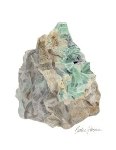Collections and databases
The collections of the department reflect almost three hundred years of collecting activities, which culminated during the late 1800s and early 1900s.
The present acquisition rate is between 300 and 500 specimens per year. New material is usually obtained on an exchange basis and by field collecting.
Collections
.jpg)
Pyrobelonite. Photo: Michael P Cooper
Mineral collection
The mineral collection comprises some 160,000 catalogued specimens, 51% of which originate from Swedish deposits. Among the specialities is a very extensive collection of minerals from the Långban mines, Filipstad, Värmland (approximately 25,000 pieces).
Classical ore deposits like Sala, Falun, Malmberget and Boliden are well-represented, as are minerals from the famous pegmatite fields of Sweden, like Ytterby, Utö and Varuträsk.
A database of the Mineral collection can be reached through our collections (filter on "NRM Mineralogy")
(filter on "NRM Mineralogy")
.jpg)
Smoky quartz. Water colour: Caroline Pettersson
Wellknown mineral collectors
The collection includes specimens that have belonged to renowned scientists like Jacob Berzelius, Wilhelm Hisinger and Gustaf Flink.
An impressing suite of 6,800 exquisite specimens, donated by the mineralogist Hjalmar Sjögren in 1901, is displayed in the original, mahogany show-cases. The department also owns the old collections of Bergskollegium (The Board of Mines; 1637-1857), transferred to the museum in 1859.
Among the peculiarities is a 22 000-kg boulder of native iron which Adolf Erik Nordenskiöld found at Uvifaq on Disko Island in 1870, during his first journey to Greenland, which is placed outside the southern wing of the museum. Read more about the Ovifak boulder.
Type specimens
The Type collection contains 117 mineral holotypes preserved at the museum. These are compiled in the list of type specimens.
Meteorite collection
The meteorite collection contains about one thousand specimens from 311 different meteorites. Most Swedish meteorites are represented, including ca 200 stones from the Hessle shower in 1869 and several Muonionalusta irons of which the largest weighs more than 200 kg. The collection is computer catalogued and can be reached through our collection (search for "Meteorite").
(search for "Meteorite").
Hedin collection
The Hedin collection consists of ca. 2200 rock specimens collected during Sven Hedins expeditions in Central Asia. A database of the Hedin collection can be reached through our collection (filter on "NRM Mineralogy" and "Hedin")
(filter on "NRM Mineralogy" and "Hedin")

Malachite. Water colour: Caroline Pettersson
Topographical collection and sample collection
The topographical collection consists of 20,000, partly not yet catalogued minerals, rocks and ores. We have also a separate sample collection with rock specimens, rock powders and mineral separates from many of the rocks dated at our isotope geology laboratory.
Nodule collection
The Nodule collection consists of iron and manganese nodules collected from the bottom of the Baltic Sea, the Bothnian Sea and the Barents Sea by researchers from Luleå Technical Univerity. It was donated to the museum in 1997. A database of the Nodule collection is available through our collections . (search for "Nodules")
. (search for "Nodules")
Use of the collections
Material from the collections is used for public exhibits and for research. Scientists who wish to obtain samples for research purposes should contact Jörgen Langhof , who is the curator in charge. Material is also available for loan (to temporary exhibitions etc.) under specified conditions
, who is the curator in charge. Material is also available for loan (to temporary exhibitions etc.) under specified conditions
Library
A library containing geological and mineralogical literature also belongs to the department, mainly for internal use among the researchers.
Databases
.png)
Welinite. Photo: Michael P Cooper
Collection databases
The main Mineral collection, the Meteorite collection, the Hedin collection and the Nodule collection can be searched for in our collections . In addition, there is a list of Type specimen. In order to search for Swedish mineral localities, you are referred to the international mineral database Mindat
. In addition, there is a list of Type specimen. In order to search for Swedish mineral localities, you are referred to the international mineral database Mindat .
.
Age database
In addition, a separate database with radiometric age determinations of Swedish rocks and minerals, has been created by the department in collaboration with the Geological Survey of Sweden (SGU). It is now hosted and maintained by the SGU. See under the Swedish radiometric age database.


